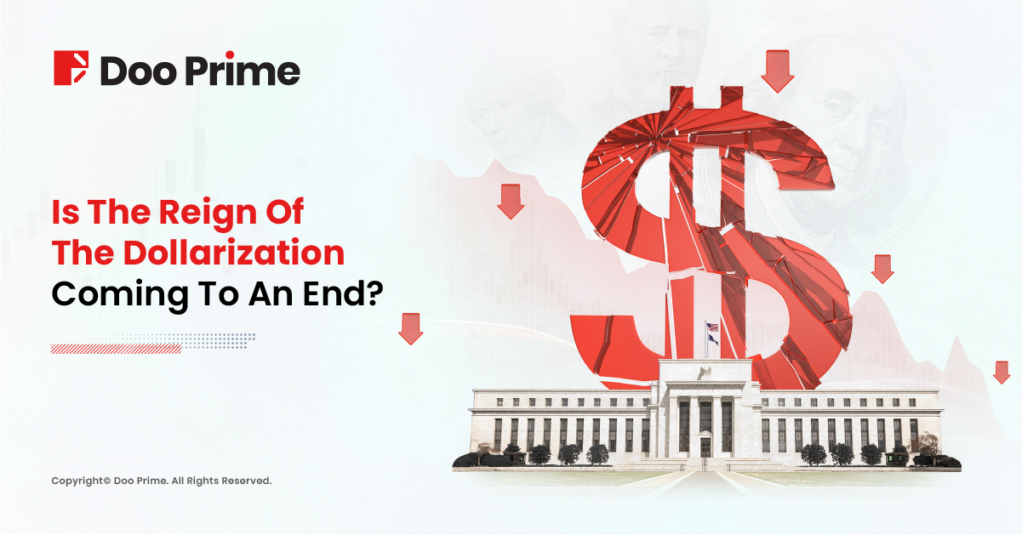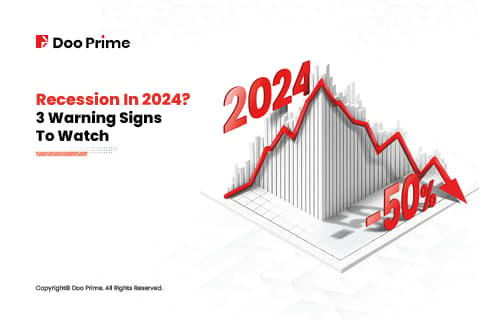
In a shift away from the traditional use of the U.S. dollar as an intermediate currency, several countries have recently reached agreements to trade directly in their own currencies.
Brazil and China have led the way, followed by India and Malaysia, with discussions also underway among the BRICS countries Brazil, Russia, India, China, and South Africa – about the creation of a new currency.
This trend towards “de-dollarization” has raised questions about the future of the U.S. dollar’s dominance as a global reserve currency and whether this marks the beginning of the end of the dollar’s dominance.

In this article, we will examine the trend towards dollarization and its implications for the global financial system, including the causes of the present-day dominance of the U.S. dollar, the dollar’s hidden problems related to debt, inflation, and economic impact, and what lies ahead for the future of global currency patterns.
Causes Of The Present-Day Dominance Of The U.S. Dollar

The present-day dominance of the U.S. dollar can be traced back to the end of World War II, when the U.S. led the establishment of the Bretton Woods system to ensure the recovery of the global economy and establish a new order of the international monetary system. This system linked the dollar directly to gold, allowing it to become the world’s leading reserve currency.
Although the Bretton Woods system collapsed in the 1970s due to the dollar’s currency overdraft, “de-dollarization” did not occur as the dollar was successfully linked to oil, with trades needing to be settled in dollars – making this strategically significant for the world economic landscape. With the subsequent wave of globalization and more frequent economic and trade exchanges between countries, coupled with the support of U.S. technology and military power, the dollar’s status as the world’s leading currency has deepened, resulting in the current dominant position of the dollar.
The Dollar’s Hidden Problems: Debt, Inflation, And Economic Impact

While the dollar remains a dominant global currency, it is not immune to underlying issues that have led countries to diversify their currency holdings for trade settlement.
The most significant problem facing the dollar is the massive U.S. debt. The U.S. GDP for 2022 is USD 25.46 trillion, while the current U.S. debt is USD 31.4 trillion, which is equivalent to a year’s worth of GDP. This poses a significant challenge for the U.S. government, as raising the debt ceiling can only delay its impact.
The huge volume of debt weakens the fiscal space of the U.S. government, and failure to raise the debt ceiling in time may lead to a government shutdown and spending cuts that could have a significant impact on the U.S. economy and financial markets.
Although the Federal Reserve’s continuous interest rate hikes in recent years have led to an increase in the interest expense on the U.S. debt, cutting debt would lead to reduced government spending, which could inhibit consumer spending, business investment, and job creation. As a result, the only realistic approach for the U.S. government at present is to continue to raise the debt ceiling.
Despite the significant amount of debt, the value of the dollar has not weakened year by year, due to the wave of globalized trade. As many countries rely on the dollar for trade settlement, they have accumulated dollar reserves to maintain economic stability, thereby helping the U.S. share the inflationary pressure to some extent.
However, the debt remains a looming risk for the dollar and the U.S. economy, with the risk of default, government shutdown, and spending cuts, all of which could have incalculable impacts on financial markets and the U.S. economy.
What Lies Ahead For The Future Of Global Currency Pattern?

Despite its significant problems, the globalized trade wave and the economic strength of the United States mean that countries worldwide continue to choose the U.S. dollar for trade settlement, despite its flaws.
This is because no other country has been able to assume a dominant position in the global market like the U.S. Although the euro was expected to challenge the dollar’s hegemony, it has experienced subtle weakening over the years and can no longer compete with the dollar’s status. This phenomenon can be likened to “finding a diamond in the rough” where despite the dollar’s issues, it still has a significant advantage compared to other currencies worldwide.
In the context of globalization, the U.S. dollar has held a hegemonic position. As long as the wave of globalization remains strong, substantial progress towards de-dollarization seems difficult.
However, in recent years, there has been a trend of “counter-globalization” which has started to replace the previously dominant wave of globalization.
This has been brought about by the disengagement of China and the United States from the European Union in the economic field, causing a shock to the era of peace and stability. As a result, some countries have begun to switch to their own currencies or other more stable currencies for trade settlement, which explains why several countries mentioned at the beginning of this article have made the switch.
While the dominance of the U.S. dollar is being challenged, achieving substantial results in the short term remains difficult. The use of too many currencies in transaction settlements will undoubtedly increase transaction costs. Thus, the choice of a single currency is in line with economic laws.
Although there are voices for de-dollarization, and some countries have switched to other currencies for settlement, it is difficult to find a more suitable currency than the U.S. dollar to assume the status of the “single currency” due to its stability and qualifications, as it would be the most stable and qualified currency among all currencies in the world.
Furthermore, despite the decline of the United States in power, there is currently no country in Europe or Asia that has surpassed its comprehensive national power. The global economic recession is a shared issue, and not solely experienced by the United States. Therefore, the comprehensive national power of the United States can still provide robust support for the dollar.
Ultimately, with its faults notwithstanding, the U.S. dollar remains the most qualified currency to drive international economic and trade development when compared to other currencies. The process of de-dollarization is more of an auxiliary tool for only a few regions or countries in the short term, and it cannot yet replace the dollar’s dominant position. Therefore, the dollar’s position is still unlikely to be shaken in the short term.
| About Doo Prime
Our Trading Products
Securities | Futures | Forex | Precious Metals | Commodities | Stock Indices
Doo Prime is an international pre-eminent online broker under Doo Group, which strives to provide professional investors with global CFD trading products in Securities, Futures, Forex, Precious Metals, Commodities, and Stock Indices. At present, Doo Prime is delivering the finest trading experience to more than 90,000 clients, with an average trading volume of more than USD 51.223 billion each month.
Doo Prime entities respectively holds the relevant financial regulatory licenses in Seychelles, Mauritius, and Vanuatu with operation centers in Dallas, Sydney, Singapore, Hong Kong, Dubai, Kuala Lumpur, and other regions.
With robust financial technology infrastructure, well-established partnerships, and an experienced technical team, Doo Prime boasts a safe and secure trading environment, competitive trading costs, as well as deposit and withdrawal methods that support 20+ different currencies. Doo Prime also incorporates 24/7 multilingual customer service and extremely fast trade execution via multiple industry-leading trading terminals such as MT4, MT5, TradingView, and Doo Prime InTrade, covering over 10,000 trading products.
Doo Prime’s vision and mission are to become a financial technology-focused broker, streamlining international global financial products investment.
For more information about Doo Prime, please contact us at:
Phone:
Europe : +44 11 3733 5199
Asia : +852 3704 4241
Asia – Singapore: +65 6011 1415
Asia – China : +86 400 8427 539
E-mail:
Technical Support: [email protected]
Account Manager: [email protected]
Forward-looking Statements
This article contains “forward-looking statements” and may be identified by the use of forward-looking terminology such as “anticipate”, “believe”, “continue”, “could”, “estimate”, “expect”, “hope”, “intend”, “may”, “might”, “plan”, “potential”, “predict”, “should”, or “will”, or other variations thereon or comparable terminology. However, the absence of such terminology does not mean that a statement is not forward-looking. In particular, statements about the expectations, beliefs, plans, objectives, assumptions, future events, or future performance of Doo Prime will be generally assumed as forward-looking statements.
Doo Prime has provided these forward-looking statements based on all current information available to Doo Prime and Doo Prime’s current expectations, assumptions, estimates, and projections. While Doo Prime believes these expectations, assumptions, estimations, and projections are reasonable, these forward-looking statements are only predictions and involve known and unknown risks and uncertainties, many of which are beyond Doo Prime’s control. Such risks and uncertainties may cause results, performance, or achievements materially different from those expressed or implied by the forward-looking statements.
Doo Prime does not provide any representation or warranty on the reliability, accuracy, or completeness of such statements. Doo Prime is not obliged to provide or release any updates or revisions to any forward-looking statements.
Risk Disclosure
Trading in financial instruments involves high risks due to the fluctuation in the value and prices of the underlying financial instruments. Due to the adverse and unpredictable market movements, large losses exceeding the investor’s initial investment could incur within a short period of time. The past performance of a financial instrument is not an indication of its future performance. Investments in certain services should be made on margin or leverage, where relatively small movements in trading prices may have a disproportionately large impact on the client’s investment and client should therefore be prepared to suffer significant losses when using such trading facilities.
Please make sure you read and fully understand the trading risks of the respective financial instrument before engaging in any transaction with Doo Prime’s trading platforms. You should seek independent professional advice if you do not understand any of the risks disclosed by us herein or any risk associated with the trade and investment of financial instruments. Please refer to Doo Prime’s Client Agreement and Risk Disclosure and Acknowledgement Notice to find out more.
Disclaimer
This information is addressed to the general public solely for information purposes and should not be taken as investment advice, recommendation, offer, or solicitation to buy or sell any financial instrument. The information displayed herein has been prepared without any reference or consideration to any particular recipient’s investment objectives or financial situation. Any references to the past performance of a financial instrument, index, or a packaged investment product shall not be taken as a reliable indicator of its future performance. Doo Prime and its holding company, affiliates, subsidiaries, associated companies, partners and their respective employees, make no representation or warranties to the information displayed and shall not be liable for any direct, indirect, special or consequential loss or damages incurred a result of any inaccuracies or incompleteness of the information provided, and any direct or indirect trading risks, profit, or loss arising from any individual’s or client’s investment.



